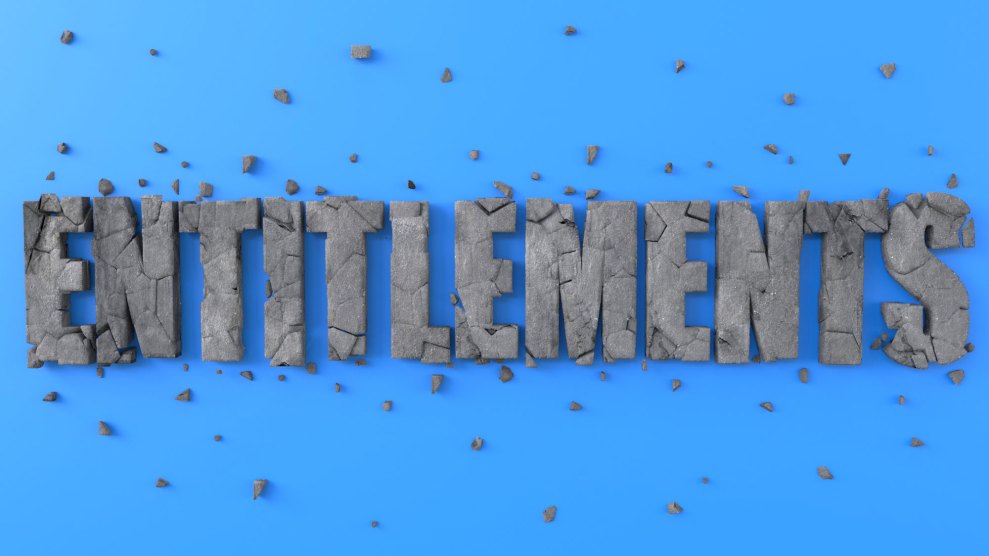(Note: this is the second in a series of critical looks at George W. Bush’s second-term agenda. Read Part One here.)
Everyone’s talking about it, no one seems to have seen it. What is it? Why, President Bush’s mythical, much-hyped, second-term agenda! On Tuesday the Washington Post reported that more than a few Republican strategists are antsy over the lack of any specific policy proposals from the Bush camp. His reelection website’s “Agenda” page is devoid of detail, and his vague hand motions about an “ownership society” remain just that — vague hand motions.
There is, of course, one big exception: health care. With over 43 million Americans lacking insurance, with health care costs shooting through the roof, and with 38 percent of Americans dissatisfied with the president’s response, Bush apparently thought he had to say something. The only problem: his health care proposals, as stated, will do little to cover the uninsured, and run the very real risk of throwing our national insurance system into utter chaos. While the media obsesses over the all-important question of whether John Kerry spent Christmas in Cambodia or not, no one seems to notice that the president is planning a full-fledged assault on health care.
Essentially, the Bush plan breaks down into three major components. First, Bush plans to offer tax credits to those low- and moderate- income individuals who do not receive health coverage from their employers. Second, he wants to use Health Savings Accounts (HSA) to create a national “catastrophic insurance” program. Third, he plans to set up Association Health Plans (AHP) that would allow small businesses to pool their resources together and negotiate better prices from insurance companies. Each sounds good in theory, but as with any policy, the devil is in the details, and our policy-averse president has no intention of struggling with the details.
Tax credits. The Bush campaign has estimated that its plan to spend $70 billion over 10 years on health tax credits will cover anywhere from 4 to 5 million people. The credits — $1,000 for individuals, $3,000 for families — would go to those families slightly above the poverty line who do not qualify for Medicaid or other state programs. (John Kerry, by contrast, would simply expand state programs.)
Seems like a lot of bang for your buck, doesn’t it? Unfortunately, the tax credits are much too small to help most families. The National Coalition on Health Care has calculated that the average family premium will rise to $14,500 by 2006 (and that’s if none of Bush’s other policies, which will likely raise premiums for low-income families, are enacted). How, exactly, does the president expect those families to come up with the remaining $10,000? Not even the sunniest of conservatives believe that malpractice reform and other gimmicks will ratchet down premiums by that much. It’s no wonder, then, that the independent Center for Budget and Policy Priorities (CBPP) figures that Bush’s tax credits will cover, at best, 10 percent of the uninsured. CBPP also pointed out that Bush expects to pay for the tax credits through cuts in other programs — the sort of budgeting chicanery that usually doesn’t add up.
More importantly — and this is a common theme in all of Bush’s health proposals — the credits offer incentive for businesses to drop their current employees. Jonathan Gruber, an economist at the Massachusetts Institute of Technology, predicts that many firms will simply drop coverage for employees, letting workers take advantage of the tax credit instead.
Two problems will then emerge. First, less-healthy individuals usually get better premium rates when they can pool together with other employees. When left to fend for themselves in the open market, these individuals will only be able to get rates far in excess of what the tax credit can cover. Hence, Gruber estimates that 1.2 million of these dropped employees won’t get any insurance at all. Second, since many young and healthy workers will simply leave their company plan to get the tax credit, premium rates would rise for all of the remaining workers in the company (since they would become, as a group, less healthy). That, in turn, would provoke the next batch of healthy workers to leave the company plan, leading to a vicious cycle of rising rates and declining coverage. In the best case scenario, then, after everything shakes out, Gruber estimates that Bush’s plan would only cover a net 1.8 million new workers. That’s it. 82 percent of the tax credits would go towards workers who are already insured, while raising rates for everyone else.
Health Savings Accounts. Health Savings Accounts (HSAs) were included in the 2003 Medicare Reform Bill, but Bush is planning to expand their scope in his second term. Basically, the government would provide high-deductible insurance to individuals — in which a family has to pay the first $2,000 in health care costs before coverage kicks in. But, they can take money out of their tax payments and put it in a Health Saving Account, where they can withdraw the money tax-free to pay for those initial costs. Furthermore, in his State of the Union address, Bush proposed that individuals who choose this “catastrophic health care coverage,” along with HSAs are allowed to deduct 100 percent of the health plan’s premium from their taxes.
Again, in theory, this isn’t a terrible idea. As the Los Angeles Times reported, many consumers like having control over how that first $2,000 is spent. Plus, when individuals are responsible for initial costs, they tend to think twice before getting unnecessary treatment, which can keep health costs down.
But in practice, Bush’s program would devastate health care as we know it, offering massive benefits to “the wealthy and the healthy”, while leaving everyone else in the dust. For starters, notice that HSAs are only attractive to a small subset of the population. A person making $25,000 a year usually can’t afford to spend $2,000 on initial health care costs, let alone save up enough to put money in a HSA. So they’ll probably opt instead for a plan with a much-higher premium. On the other hand, someone making $100,000 a year can easily afford those initial costs, and can also save up enough money to create a sizable, tax-free health care kitty in the HSA. Oh, and notice that the second, wealthier person basically pays no insurance premium (since it’s tax-deductible). It’s quite the deal. Notice also that younger, healthier individuals will take the HSAs, since they can likely avoid paying that initial $2,000, and thus get free catastrophic insurance — along with a nice little tax shelter to pay for future medical costs!
Would this actually happen? It has in the past; consider that only 80,000 people nationwide have bought into Archer Medical Savings Accounts, a close cousin of Bush’s HSAs. Furthermore, Health Services Research, a medical journal, recently published two studies showing that such “defined contribution plans” attract primarily the wealthy and healthy — everyone else stays away.
We then get the same vicious cycle that we saw with the tax credits. Employers start purging their employees from the ranks — sending them into individual HSA plans — and premiums go up, provoking a new round of purges. Meanwhile, the premiums for traditional plans go up — since the healthy folks are no longer around to subsidize the sick. That means insurance companies try to find ways to avoid covering the sickest and most expensive individuals. Note also that wealthier seniors would likely opt in to the accounts, so as to save on out-of-pocket expenses, meaning that Medicare coverage for the elderly would be adversely affected.
In essence, Bush’s proposal aims for the exact opposite of what John Kerry is trying to do. By getting the government to cover the priciest medical bills, Kerry’s health care plan would give insurance companies incentive to cover more people, and hence let everyone share the risk. Bush’s health care plan would shatter the very concept of community pooling — a surefire way to drive up insurance costs.
Most distressingly, the savings accounts would further bankrupt the federal government by diverting away a large share of tax revenue, leaving Washington unable to respond if and when the private insurance system implodes. In an April study, the Center for Budget and Policy Priorities noted that the savings accounts “breached a longstanding bright-yellow line” by making both deposits and withdrawals tax-free. While the Bush campaign has estimated that the HSA proposal would only cost $150 billion over the next ten years, in the long term the program would divert “some hundreds of billions or even trillions of dollars of what otherwise would have been taxable income.”
Oh, and this fiscal crisis will get us — even by the Bush campaign’s most over-bloated calculations — would cover a mere 1.9 million of the 44 million uninsured. (The actual number, according to MIT economist Jonathan Gruber, is probably closer to 350,000).
Association Health Plans. Bush’s final proposal would create Association Health Plans (AHPs) for small businesses, allowing those companies to pool their insurance risk on a national level in order to negotiate better premium rates. Again: laudable in theory, disastrous in practice. Studies have shown time and again that AHPs do little to cover the unemployed. The nonpartisan Congressional Budget Office (CBO) estimated in 2003 that the plan would only cover an additional 600,000 workers, at a price of $245 million. Meanwhile, a study by Mercer Risk, Finance, and Insurance Consulting found that AHPs could increase the number of uninsured by over a million — in part because the plan would spur (yet again!) a vicious “adverse selection” cycle among employers.
Indeed, the CBO estimated that the vicious cycle would raise premiums for 80 percent of businesses, mainly because those companies that joined an AHP would likely band together with healthier groups and individuals. Everyone else gets left out. Meanwhile, the Center for American Progress observed that those workers who stay in an AHP will no longer be protected by state regulations, meaning that businesses could craft insurance policies to weed out the less healthy. Indeed, because businesses would no longer operate under state oversight, consumers would find themselves at greater risk for fraud. (This sort of thing happened in the 1970s, when Congress experimented with a similar program — the “multiple employer welfare arrangements.)
All of Bush’s major health care proposals have a few characteristics in common. They would give large businesses a chance to cast their workers out into the open market. The proposals would eradicate the practice of community pooling, instead creating a two-layered system of healthy individuals with low premiums and sick individuals with unaffordable premiums. And they would allow insurance companies to jack up premiums for those who need medical coverage the most. And together the proposals would cover only a tiny fraction of the 44 million uninsured Americans. Tell us again why Swift Boat Veterans are dominating the news cycle?
















